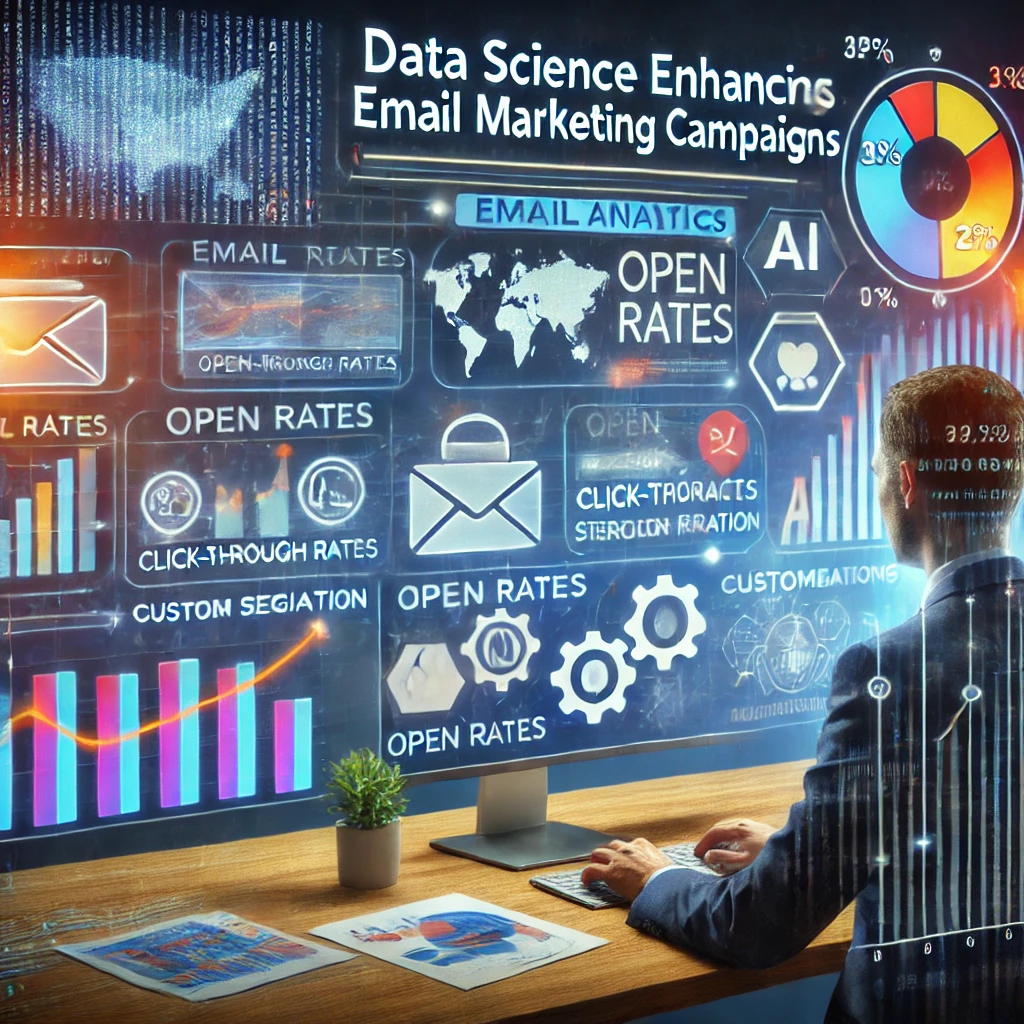How Data Science Improves Email Marketing Campaigns
Email marketing is one of the strongest channels for connecting with customers, but that’s not enough these days in this overcrowded inbox. Marketers need to get smarter about the way they compose and optimize campaigns. It’s here that data science plays an important role. Techniques that employ data science can take an email marketing strategy that was just a regular old newsletter and turn it into highly personalized, targeted campaigns delivering better engagement and higher conversion rates.
Digital marketing and data science are increasingly becoming interwoven in today’s digital-first world. The ability of digital marketers to make better decisions, optimize campaigns, and deliver more personalized experiences to customers depends on the power of data science.
How Data Science Improves Email Marketing Campaigns
We will see how data science is changing the dynamics of improving campaigns through email marketing.
-
Personalization at Scale
Personalization is one of the most powerful aspects of email marketing, and it lies at the heart of data science in delivering it effectively.
How Data Science Helps:
Segmentation: Data science tools help in making very segmented email lists based on demographics, past behaviors, and purchase history by analyzing customer data. You can now send targeted content instead of a generic e-mail to your list because it resonates with the audience.
- Dynamic Content: A machine learning model predicts what sort of content images, subject lines, or offers will resonate with whom based on that person’s behavior, interests, and preferences. For instance, an email sent to a promotion of a sale on sports equipment will have one message for the person who previously purchased gym gear and another message for the person who previously bought running shoes.
- Predictive Personalization: Data science will be able to predict what products or services a customer is most likely to buy so marketers can send recommendations that feel timely and relevant. This not only boosts open rates but also drives higher conversion rates.
-
Optimal Send Times
Timing is everything in an email marketing strategy. Sending a message at times when the maximum number of email recipients will check and engage themselves with the information is the biggest success in such a campaign.
How Data Science Helps:
- Send-Time Optimization: Based on their historical data, machine learning algorithms can find the best time for sending emails to individual users; this may be their past email opening times, a location, some device preferences, and their entire engagement history.
- Behavioral Patterns: Data science models recognize the pattern of interaction in regard to emails in the way how people spend their time reading emails during morning hours, late at night, etc. With this, the auto email will be delivered at the probable opening time for the recipient.
-
A/B Testing and Multivariate Testing
It has one of the oldest staples, A/B testing, for email marketing, but with data science, it will go to another level with far more advanced testing and insights.
How Data Science Helps
- Automated A/B Testing: The process in place will automate, instead of just testing a subject line or a CTA, running a great number of tests simultaneously and seeing which of these combinations work the best.
- Statistical Significance: Data science tools do not only test different variables, such as subject lines, images, and content layout, but they also ensure the results are statistically significant. This will enable marketers to make quick, data-driven decisions and optimize their campaigns in real time.
- Multivariate Testing: Multivariate testing is more advanced than A/B testing. At this stage, multiple variables will be tested. Marketers here can test what works best in different combinations for subject lines, CTAs, and images.
-
Predictive Analytics for Customer Behavior
Predictive analytics has been the most powerful application of data science in email marketing. Using historical data and machine learning models, marketers can predict future behavior and send the most relevant content at the right time.
How Data Science Helps
- Churn Prediction: The data science models can identify who is likely to unsubscribe or become inactive. Then marketers target these specific customers with some re-engagement campaigns or other special offers, so they keep them on.
- Purchase Predictions: It can predict the products that a customer is likely to purchase in the future using data science analysis of his buying history and his browsing behavior. Using this, marketers can send targeted emails to the customer at the right time with those products.
- Lifetime Value Prediction: Data science helps estimate how much value a customer will bring to their business in the future. In other words, estimate the lifetime value of your customers- Customer Lifetime Value, or CLV. Marketers may use such predictions to determine whom to focus on, especially when offering special promotions, loyalty rewards, or special offers.
-
Improve Email Design and Content Optimization
Data science optimizes content and design related to email marketing to create more attractive and effective communications.
How Data Science Works:
- Content optimization: machine models analyze past campaigns as to which contents (images, videos, description of products) work best in a campaign and then marketers create their emails after optimizing them against the data in question.
- Natural Language Processing: This is one segment of AI that enables marketers to know whether the customer feels positive about any response given for an email and content accordingly. If there is a good review or testimonial that was engaged by the customer through the email, then NLP could identify such similarities and emphasize that in further emails.
- Subject Line Analysis: Data science tools can test and optimize subject lines by analyzing the highest open rates to help marketers pick the right approach to grabbing recipients’ attention.
-
Automation and Workflow Optimization
This is one of the greatest strengths of data science in email marketing: automation. Marketers integrate predictive analytics, machine learning, and data-driven insights into their workflow to automate it and save valuable time while increasing precision.
How Data Science Helps
- Auto Email Sequences. Based on the user action, applying data science, the email marketing platform can trigger a sequence of automated, tailored emails. For instance, if a customer abandons the cart, an automated workflow may automatically send a reminder email or possibly offer a discount, all this triggered by a customer’s actions.
- Behavioral-Based Campaigns: Emails can automatically be triggered through customer behavior like clicking on a link, visiting a product page, or making a purchase. That level of automation ensures timely and relevant communication without manual intervention.
- Customer Journey Mapping: Data science allows marketers to map out the customer journey through tracking interactions and behaviors over time. This enables the creation of targeted email workflows for different stages in the customer lifecycle.
-
Data-Driven Email List Management
The quality of your email list is the biggest determinant of whether your email marketing campaigns are going to work or not. Data science aids in building and managing a more targeted, clean, and efficient email list.
How Data Science Helps:
- List Cleaning and Validation: Data science tools automatically detect invalid, outdated, or unengaged email addresses and remove them from the list. This will improve email deliverability and make sure that the campaigns reach the most relevant audience.
- Engagement Scoring: Data science will score leads with engagement metrics like opens, click-through rates, and interaction with prior emails. Thus, it allows the marketer to zero in on his most active customer and makes campaigns in email marketing overall more successful.
-
Real-Time Analytics and Campaign Optimization
Data science allows a marketer to track data in real time. Hence it can optimize its campaigns at the nanosecond level.
How Data Science Helps
- Live Statistical Feedback: Data science tools enable an accurate means of tracking open, click, or other engagements in real-time. Marketers can thus adjust the system for maximum performance.
- Behavioral Optimization: The email content and delivery times change with data models as the users go about their activity in real time. Each recipient receives the relevant content when he is most likely to interact with it.
Data science has increasingly been applied to email marketing and the way campaigns are executed and optimized. Advanced analytics, machine learning, predictive modeling, and automation all come together to help marketers compose more personalized, timely, and engaging emails for customers. Improved engagement and customer satisfaction make it easier to get higher conversion rates and ROI.
As the science of data grows, its implementation in email marketing will become more essential for marketers who want to be ahead of the curve and refine strategies to achieve the best results.




